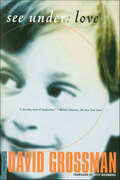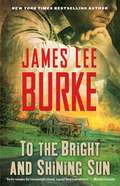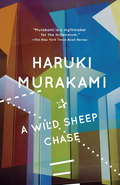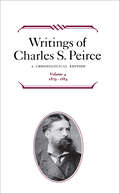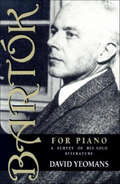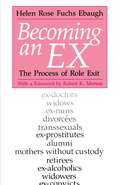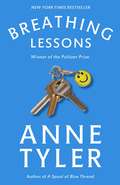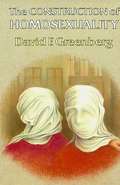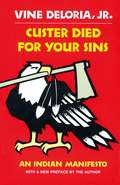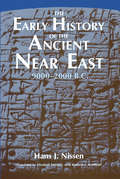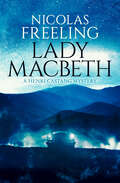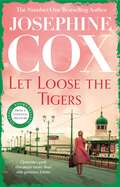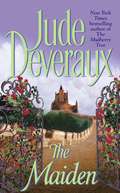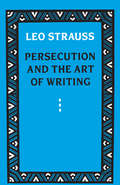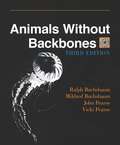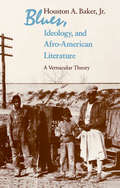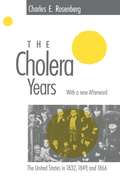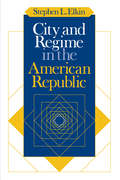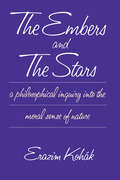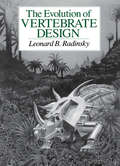- Table View
- List View
See Under: A Novel
by David GrossmanDavid Grossman's masterly fusing of vision, thought, and emotion make See Under: Love a luminously imaginative and profoundly affecting work. In this powerful novel by one of Israel's most prominent writers, Momik, the only child of Holocaust survivors, grows up in the shadow of his parents' history. Determined to exorcise the Nazi "beast" from their shattered lives and prepare for a second holocaust he knows is coming, Momik increasingly shields himself from all feeling and attachment. But through the stories his great-uncle tells him—the same stories he told the commandant of a Nazi concentration camp—Momik, too, becomes "infected with humanity." "A dazzling work of imagination."--Michiko Kakutani, The New York Times
To the Bright and Shining Sun
by James Lee BurkeThis early novel from bestselling author James Lee Burke is a gritty coming-of-age story about a young Kentucky miner growing up in the Appalachian mountains who’s torn between his family life and the lure of the city.James Lee Burke, a writer who “can touch you in ways few writers can” (The Washington Post) brings his brilliant feel for time and place to this stunning story of Appalachia in the early 1960s. Here, Perry Woodson Hatfield James, a young man torn between family honor and the lure of seedy watering holes, must somehow survive the tempestuous journey from boyhood to manhood and escape the dark and atavistic heritage of the Cumberland Mountains.
A Wild Sheep Chase: A Novel (Vintage International)
by Haruki MurakamiA New York Times bestselling author—and &“a mythmaker for the millennium, a wiseacre wiseman&” (New York Times Book Review)—delivers a surreal and elaborate quest that takes readers from Tokyo to the remote mountains of northern Japan, where the unnamed protagonist has a surprising confrontation with his demons. An advertising executive receives a postcard from a friend and casually appropriates the image for an advertisement. What he doesn&’t realize is that included in the scene is a mutant sheep with a star on its back, and in using this photo he has unwittingly captured the attention of a man who offers a menacing ultimatum: find the sheep or face dire consequences.
Writings of Charles S. Peirce: A Chronological Edition (Writings of Charles S. Peirce)
by Charles S. Peirce"The volumes are handsomely produced and carefully edited, . . . For the first time we have available in an intelligible form the writings of one of the greatest philosophers of the past hundred years . . . " —The Times Literary Supplement" . . . an extremely handsome and impressive book; it is an equally impressive piece of scholarship and editing." —Man and World
Bartók for Piano: A Survey of His Solo Literature
by David Yeomans" . . . detailed and thorough . . . a wealth of information . . . David Yeomans deserves our thanks for a job exceedingly well done." —American Music Teacher" . . . a must for pianists . . . " —American Reference Book Annual"David Yeomans's study is certainly to be recommended for all good music libraries, pianists and students of Bartók." —The Music Review"Although there are currently more than 15 books in print about composer Béla Bartók, this short volume is unique in its focus on his complete oeuvre for solo piano. . . . Recommended for pianists, piano teachers, and students from lower-division undergraduate level and above." —Choice" . . . the entire book is indispensable for any of us before we play another Bartók piece." —Clavier"This work collects in one place an enormous number of 'facts' about the piano music of Bartók . . . for planning concerts and student repertoire, and as a survey of an important body of 20th-century music, this listing is valuable." —Library JournalThis chronological listing of more than 400 pieces and movements presents in convenient form essential information about each of Bartók's solo piano works, including its various editions, timing, level of difficulty, pertinent remarks by the composer, and bibliographical references to it.
Becoming an Ex: The Process of Role Exit
by Helen Rose Fuchs EbaughThe experience of becoming an ex is common to most people in modern society. Unlike individuals in earlier cultures who usually spent their entire lives in one marriage, one career, one religion, one geographic locality, people living in today's world tend to move in and out of many roles in the course of a lifetime. During the past decade there has been persistent interest in these "passages" or "turning points," but very little research has dealt with what it means to leave behind a major role or incorporate it into a new identity. Helen Rose Fuchs Ebaugh's pathbreaking inquiry into the phenomenon of becoming an ex reveals the profundity of this basic aspect of establishing an identity in contemporary life. Ebaugh is herself an ex, having left the life of a Catholic nun to become a wife, mother, and professor of sociology. Drawing on interviews with 185 people, Ebaugh explores a wide range of role changes, including ex-convicts, ex-alcoholics, divorced people, mothers without custody of their children, ex-doctors, ex-cops, retirees, ex-nuns, and—perhaps most dramatically—transsexuals. As this diverse sample reveals, Ebaugh focuses on voluntary exits from significant roles. What emerges are common stages of the role exit process—from disillusionment with a particular identity, to searching for alternative roles, to turning points that trigger a final decision to exit, and finally to the creation of an identify as an ex.Becoming an Ex is a challenging and influential study that will be of great interest to sociologists, mental health counselors, members of self-help groups such as Alcoholics Anonymous and Parents Without Partners, those in corporate settings where turnover has widespread implications for the organization, and for anyone struggling through a role exit who is trying to establish a new sense of self.
Breathing Lessons: A Novel
by Anne TylerWINNER OF THE PULITZER PRIZE • NEW YORK TIMES BESTSELLER • Evoking Jane Austen, Emma Straub, and other masters of the literary marriage, Breathing Lessons celebrates the small miracles and magic of truly knowing someone.Unfolding over the course of a single emotionally fraught day, this stunning novel encompasses a lifetime of dreams, regrets and reckonings—and is oftern regarded as Tyler's seminal work. Maggie and Ira Moran are on a road trip from Baltimore, Maryland to Deer Lick, Pennsylvania to attend the funeral of a friend. Along the way, they reflect on the state of their marriage, its trials and its triumphs—through their quarrels, their routines, and their ability to tolerate each other&’s faults with patience and affection. Where Maggie is quirky, lovable and mischievous, Ira is practical, methodical and mired in reason. What begins as a day trip becomes a revelatory and unexpected journey, as Ira and Maggie rediscover the strength of their bond and the joy of having somebody with whom to share the ride, bumps and all.&“More powerful and moving than anything [Tyler] has done.&” —Los Angeles Times
Confronting The New Age: How To Resist A Growing Religious Movement
by Walter Martin Doug GroothuisThe first book to tell you how to confront the New Age The threat is growing. So not only do we need to understand the New Age, we need to stem the tide of this growing religious movement. Here's the first book that tells how. You'll find all you need to know for: - Witnessing to New Age adherents - Identifying New Age influences in business seminars - Exposing New Age curriculum in our public schools - Discerning New Age influences in pop psychology, biofeedback therapy, visualization, and New Age music This book takes you a step beyond other books with its practical advice and sound suggestions.
The Construction of Homosexuality
by David F. Greenberg"At various times, homosexuality has been considered the noblest of loves, a horrible sin, a psychological condition or grounds for torture and execution. David F. Greenberg's careful, encyclopedic and important new book argues that homosexuality is only deviant because society has constructed, or defined, it as deviant. The book takes us over vast terrains of example and detail in the history of homosexuality."—Nicholas B. Dirks, New York Times Book Review
Custer Died For Your Sins: An Indian Manifesto
by Vine DeloriaStanding Rock Sioux activist, professor, and attorney Vine Deloria, Jr., shares his thoughts about U.S. race relations, federal bureaucracies, Christian churches, and social scientists in a collection of eleven eye-opening essays infused with humor.This &“manifesto&” provides valuable insights on American Indian history, Native American culture, and context for minority protest movements mobilizing across the country throughout the 1960s and early 1970s. Originally published in 1969, this book remains a timeless classic and is one of the most significant nonfiction works written by a Native American.
The Early History of the Ancient Near East, 9000–2000 B.C.
by Hans J. Nissen Kenneth J. NorthcottHans J. Nissen here provides a much-needed overview of 7000 years of development in the ancient Near East from the beginning of settled life to the formation of the first regional states. His approach to the study of Mesopotamian civilization differs markedly from conventional orientations, which impose a sharp division between prehistoric and historic, literate, periods. Nissen argues that this approach is too rigid to explain the actual development of that civilization. He deemphasizes the invention of writing as a turning point, viewing it as simply one more phase in the evolution of social complexity and as the result of specific social, economic, and political factors. With a unique combination of material culture analysis written data, Nissan traces the emergence of the earliest isolated settlements, the growth of a network of towns, the emergence of city states, and finally the appearance of territorial states. From his synthesis of the prehistoric and literate periods comes a unified picture of the development of Mesopotamian economy, society, and culture. Lavishly illustrated, The Early History of the Ancient Near East, 9000-2000 B.C. is an authoritative work by one of the most insightful observers of the evolution and character of Mesopotamian civilization.
Hegel's Phenomenology of Spirit (Studies in Phenomenology & Existential Philosophy)
by Martin HeideggerThe text of Martin Heidegger's 1930-1931 lecture course on Hegel's Phenomenology of Spirit contains some of Heidegger's most crucial statements about temporality, ontological difference and dialectic, and being and time in Hegel. Within the context of Heidegger's project of reinterpreting Western thought through its central figures, Heidegger takes up a fundamental concern of Being and Time, "a dismantling of the history of ontology with the problematic of temporality as a clue." He shows that temporality is centrally involved in the movement of thinking called phenomenology of spirit.
The Knockout Artist
by Harry CrewsCrews&’s novel about a boxer with the gift of knocking himself unconscious, with a new foreword by New York Times-bestselling author S. A. Cosby A Penguin ClassicA favorite of longtime Harry Crews fans, The Knockout Artist (1988) portrays Eugene Talmadge Biggs, a young boxer from rural Georgia whose champion rise is diverted by a vulnerability, or gift, for knocking himself unconscious. As he begins to exploit his talents, the notorious Knockout Artist journeys a hero&’s descent into the New Orleans underworld and meets characters who have long since checked their morals at the door. The unforgettable climax shows Crews at his virtuoso best, when Eugene confronts his truth, and sets out to claim his freedom and win his own self-respect.
Lady Macbeth (The Henri Castang Mysteries)
by Nicolas FreelingRenowned French Detective Castang investigates a missing wife and her suspicious husband in this mystery from an Edgar award–winning British crime writer.Guy and Sibille Lebfevre had what most people would call a normal marriage—until they have an argument while on a road trip through the Vosges mountains. Enraged, Sibille gets out of the car, disappearing on the otherwise deserted road, never to be heard from again.Six months later, Guy has not even bothered to look for his wife. When Inspector Castang questions him, Guy claims his wife is too proud to come home. This does not sit right with Castang or anyone close to Sibille, as they all suspect her husband of murdering her. But as Castang soon realizes, no one really knows what happens—or doesn’t happen—between a husband and wife. . . . Praise for Nicolas Freeling:“In depth of characterization, command of language and breadth of thought, Mr. Freeling has few peers when it comes to the international policier.” —The New York Times“Nicolas Freeling . . . liberated the detective story from page-turning puzzler into a critique of society and an investigation of character.” —The Daily Telegraph“Freeling rewards with his oblique, subtly comic style.” —Publishers Weekly“Freeling writes like no one. . . . He is one of the most literate and idiosyncratic of crime writers.” —Los Angeles Times
Let Loose the Tigers: Passions run high when the past releases its secrets (Queenie's Story, Book 2)
by Josephine CoxAs she retraces her steps back north, Queenie threatens to disturb more than one person's future... In the sequel to Her Father's Sins, Josephine Cox writes a captivating saga in Let Loose the Tigers, in which Queenie returns to Blackburn... and to her past. Perfect for fans of Kitty Neale and Rosie Goodwin.Queenie Bedford fled her native Blackburn and the bitter knowledge that she and Rick Marsden, the man she loved, could never marry. But in 1965 she returns north again to stand by her friend Sheila Thorogood, imprisoned for running a brothel with her mother Maisie. Though Rick had vowed to find her, Queenie takes care that he should not know of her whereabouts.The magnificent Edwardian house in Blackpool is sadly neglected - but Queenie moves in with the ailing Maisie, and sets about transforming it into a sparklingly clean, highly respectable guesthouse. Meanwhile, Queenie meets the frail and confused Hannah Jason, locked away years ago for murder, and desperate for news of her long-lost son. As Rick continues his dogged search for Queenie, she sets out to find Hannah's son. But both their enquiries threaten to unlock the cage where crucial secrets have long been held captive. What readers have been saying about Let Loose the Tigers: 'This book was brilliant, once you pick it up you cannot put it down because you need to know what happens next''Keeps you spellbound till the end'
Let Loose the Tigers: Passions run high when the past releases its secrets (Queenie's Story, Book 2)
by Josephine CoxAs she retraces her steps back north, Queenie threatens to disturb more than one person's future... In the sequel to Her Father's Sins, Josephine Cox writes a captivating saga in Let Loose the Tigers, in which Queenie returns to Blackburn... and to her past. Perfect for fans of Kitty Neale and Rosie Goodwin.Queenie Bedford fled her native Blackburn and the bitter knowledge that she and Rick Marsden, the man she loved, could never marry. But in 1965 she returns north again to stand by her friend Sheila Thorogood, imprisoned for running a brothel with her mother Maisie. Though Rick had vowed to find her, Queenie takes care that he should not know of her whereabouts.The magnificent Edwardian house in Blackpool is sadly neglected - but Queenie moves in with the ailing Maisie, and sets about transforming it into a sparklingly clean, highly respectable guesthouse. Meanwhile, Queenie meets the frail and confused Hannah Jason, locked away years ago for murder, and desperate for news of her long-lost son. As Rick continues his dogged search for Queenie, she sets out to find Hannah's son. But both their enquiries threaten to unlock the cage where crucial secrets have long been held captive. What readers have been saying about Let Loose the Tigers: 'This book was brilliant, once you pick it up you cannot put it down because you need to know what happens next''Keeps you spellbound till the end'
The Maiden (Romántica Bolsillo Ser. #Vol. 68)
by Jude DeverauxThe New York Times bestselling author of The Mulberry Tree weaves a dazzling historical romance about two royal enemies who cannot fight the passion between them.He was wise, strong, and brave. His destiny was to be king. She was young and beautiful, a warrior princess. Her destiny was to love him. But when first they met, it was not as princess and king—it was as man and woman only, consumed by a passion so sudden, so deep that the very world exploded with one kiss. Only later, with his touch still burning on her lips, did Jura discover that the knight of her secret tryst had been none other than the hated Prince Rowan. Rowan, who had returned from far-away England to usurp her brother&’s throne...Rowan, who vowed to unite the wild clans under his rule. Furious, Jura swore her enmity to the golden-haired prince whose glorious visage tormented her days and haunted her nights. But nothing would stop Rowan from ruling over the warring tribes...and nothing would stop him from winning the fierce and lovely Jura as his bride, his Queen, his love....
Persecution and the Art of Writing
by Leo StraussThe essays collected in Persecution and the Art of Writing all deal with one problem—the relation between philosophy and politics. Here, Strauss sets forth the thesis that many philosophers, especially political philosophers, have reacted to the threat of persecution by disguising their most controversial and heterodox ideas.
The World of Late Antiquity: Ce 150-750 (World of Art #0)
by Peter BrownA remarkable study in social and cultural change that explains how and why the late antique world (circa 150–750CE) came to differ from "classical civilization." The first century CE was one of momentous events: the end of the Roman Empire, the rise of Christianity across Western Europe, and the disappearance of Persia from the Near East. An era in which the most deep-rooted ancient institutions disappeared, creating divergent legacies that are still present today. Renowned historian Peter Brown examines these changes and the reactions to them to show that the late antiquity was an outstanding period of new beginnings with far-reaching impacts. The result is a lucid answer to a crucial question in world history: how the exceptionally homogenous Mediterranean world of the first century CE became divided into the three mutually estranged societies of the Middle Ages: Catholic Western Europe, Byzantium, and the Islamic world. Brown’s remarkable study in social and cultural transformation explains how and why the late antique world came to differ from the "classical civilization" of the Greeks and Romans. Featuring a new preface and updated with color illustrations throughout, The World of Late Antiquity demonstrates that we still have much to learn from this enduring and intriguing period of history.
Animals Without Backbones: An Introduction to the Invertebrates (New Plan Texts at the University of Chicago)
by John Pearse Ralph Buchsbaum Mildred Buchsbaum Mildredd BuchsbaumAnimals Without Backbones has been considered a classic among biology textbooks since it was first published to great acclaim in 1938. It was the first biology textbook ever reviewed by Time and was also featured with illustrations in Life. Harvard, Stanford, the University of Chicago, and more than eighty other colleges and universities adopted it for use in courses. Since then, its clear explanations and ample illustrations have continued to introduce hundreds of thousands of students and general readers around the world to jellyfishes, corals, flatworms, squids, starfishes, spiders, grasshoppers, and the other invertebrates that make up ninety-seven percent of the animal kingdom. This new edition has been completely rewritten and redesigned, but it retains the same clarity and careful scholarship that have earned this book its continuing readership for half a century. It is even more lavishly illustrated than earlier editions, incorporating many new drawings and photographs. Informative, concise legends that form an integral part of the text accompany the illustrations. The text has been updated to include findings from recent research. Eschewing pure morphology, the authors use each group of animals to introduce one or more biological principles. In recent decades, courses and texts on invertebrate zoology at many universities have been available only for advanced biology majors specializing in this area. The Third Edition of Animals Without Backbones remains an ideal introduction to invertebrates for lower-level biology majors, nonmajors, students in paleontology and other related fields, junior college and advanced high school students, and the general reader who pursues the rewarding study of the natural world.
Blues, Ideology, and Afro-American Literature: A Vernacular Theory
by Houston A. Baker Jr.Relating the blues to American social and literary history and to Afro-American expressive culture, Houston A. Baker, Jr., offers the basis for a broader study of American culture at its "vernacular" level. He shows how the "blues voice" and its economic undertones are both central to the American narrative and characteristic of the Afro-American way of telling it.
The Cholera Years: The United States in 1832, 1849, and 1866
by Charles E. RosenbergCholera was the classic epidemic disease of the nineteenth century, as the plague had been for the fourteenth. Its defeat was a reflection not only of progress in medical knowledge but of enduring changes in American social thought. Rosenberg has focused his study on New York City, the most highly developed center of this new society. Carefully documented, full of descriptive detail, yet written with an urgent sense of the drama of the epidemic years, this narrative is as absorbing for general audiences as it is for the medical historian. In a new Afterword, Rosenberg discusses changes in historical method and concerns since the original publication of The Cholera Years. "A major work of interpretation of medical and social thought . . . this volume is also to be commended for its skillful, absorbing presentation of the background and the effects of this dread disease."—I.B. Cohen, New York Times "The Cholera Years is a masterful analysis of the moral and social interest attached to epidemic disease, providing generally applicable insights into how the connections between social change, changes in knowledge and changes in technical practice may be conceived."—Steven Shapin, Times Literary Supplement "In a way that is all too rarely done, Rosenberg has skillfully interwoven medical, social, and intellectual history to show how medicine and society interacted and changed during the 19th century. The history of medicine here takes its rightful place in the tapestry of human history."—John B. Blake, Science
City and Regime in the American Republic
by Stephen L. ElkinStephen L. Elkin deftly combines the empirical and normative strands of political science to make a powerfully original statement about what cities are, can, and should be. Rejecting the idea that two goals of city politics—equality and efficiency—are opposed to one another, Elkin argues that a commercial republic could achieve both. He then takes the unusual step of addressing how the political institutions of the city can help to form the kind of citizenry such a republic needs. The present workings of American urban political institutions are, Elkin maintains, characterized by a close relationship between politicians and businessmen, a relationship that promotes neither political equality nor effective social problem-solving. Elkin pays particular attention to the issue of land-use in his analysis of these failures of popular control in traditional city politics. Urban political institutions, however, are not just instruments for the dispensing of valued outcomes or devices for social problem-solving—they help to form the citizenry. Our present institutions largely define citizens as interest group adversaries and do little to encourage them to focus on the commercial public interest of the city. Elkin concludes by proposing new institutional arrangements that would be better able to harness the self-interested behavior of individuals for the common good of a commercial republic.
The Embers and the Stars: A Philosophical Inquiry into the Moral Sense of Nature
by Erazim Kohák"It is hard to put this profound book into a category. Despite the author's criticisms of Thoreau, it is more like Walden than any other book I have read. . . . The book makes great strides toward bringing the best insights from medieval philosophy and from contemporary environmental ethics together. Anyone interested in both of these areas must read this book."—Daniel A. Dombrowski, The Thomist "Those who share Kohák's concern to understand nature as other than a mere resource or matter in motion will find his temporally oriented interpretation of nature instructive. It is here in particular that Kohák turns moments of experience to account philosophically, turning what we habitually overlook or avoid into an opportunity and basis for self-knowledge. This is an impassioned attempt to see the vital order of nature and the moral order of our humanity as one."—Ethics
Evolution of Vertebrate Design
by Leonard B. RadinskyThe Evolution of Vertebrate Design is a solid introduction to vertebrate evolution, paleontology, vertebrate biology, and functional, comparative anatomy. Its lucid style also makes it ideal for general readers intrigued by fossil history. Clearly drawn diagrams illustrate biomechanical explanations of the evolution of fins, jaws, joints, and body shapes among vertebrates. A glossary of terms is included. "A luminous text is matched by lucid drawings rationally placed. . . . A great teaching monograph, the book will charm lay readers of fossil history. For virtually every college & public collection."—Scitech Book News
